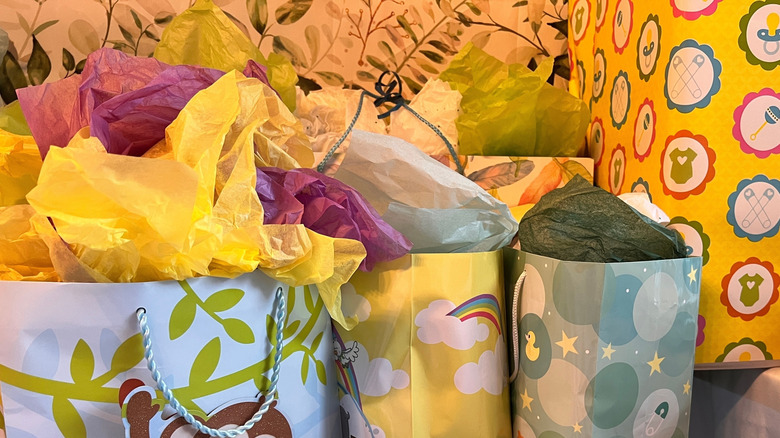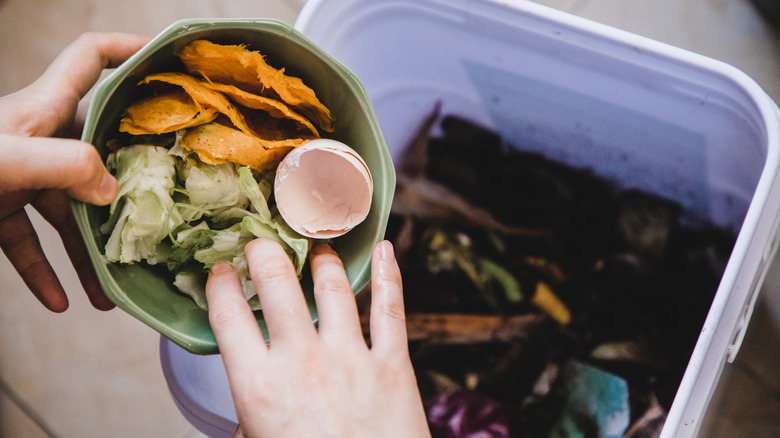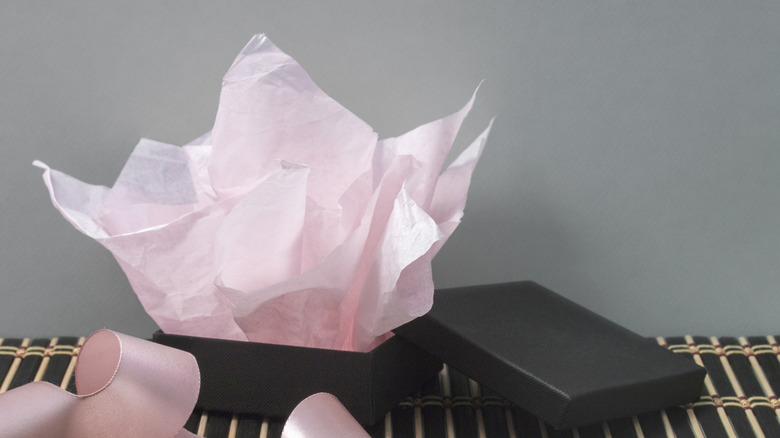From Gift Wrap To The Garden: Why Reusing Tissue Paper Is A Smart Solution
Tissue paper has long played a role in the gift wrapping and the packing industry. It not only serves to protect delicate items, but it can elevate the aesthetic presentation of the overall gift packaging. You can match the bag with complementary colors and patterns, even going out of your way to print custom tissue paper with more personalized elements. But Americans spend approximately $2.5 billion on gift wrapping every year, which equals a lot of waste once those gifts are opened. Luckily, tissue paper can be composted for your garden – if it fits the right criteria.
While paper products can be recycled upward of 25 times, tissue paper is different. It cannot be recycled into paper again, so one option would be to compost the tissue paper. However, there are restrictions. Anything with foil, glitter, or a plastic shiny coating cannot be composted. Your best bet with this kind of tissue paper is reusing it. There is no harm in repackaging the same gift bags to send back-and-forth between family and friends to reduce the environmental impact. There are even ways to repurpose leftover tissue paper around the house if you have a strong pull toward DIY and artsy projects.
The benefits of using tissue paper as garden compost material
Composting is a natural process where bacteria and fungi break down organic materials to create a nutrient-rich soil additive. Typically, the materials used for compost include grass clippings, leaves, and food scraps, but most natural paper products are also compostable. Many homes will have a green trash bin for compost materials to be picked up by the local municipality's sanitation workers every week, but your own gardening efforts can be greatly improved by DIYing your own compost. Today's trash can become tomorrow's treasure as you recycle your leftovers into something that can help more plants and vegetables grow, reducing your overall carbon footprint.
It is easy to begin a home compost, whether you have a full backyard garden space or not. You can break down your compostable materials, chopping up leftover food scraps or tearing tissue paper into tiny pieces, before leaving it piled in a bin outside until it naturally decomposes. You can use worms in a process called vermicomposting that is easier to fit into smaller, dark containers, which are insulated from the cold somewhere within your home (perhaps under the kitchen sink). Either way, composting will create a soil-like mulch that you can spread around your gardens, returning tissue paper products to nature.
Other ways to repurpose tissue paper in your home
As mentioned, some tissue papers cannot be composted — especially if they have been processed with plastic materials or accents like glitter. You can reuse tissue paper for arts and crafts projects for the kids, or you could donate it to a local school and/or community center. Tissue paper makes great collage material, and its translucent, colorful construction means you can create a stained-glass effect by attaching the paper to your windows. Creating floral designs using the delicate folds of tissue paper has been in vogue for centuries and could be a nice way to accentuate serving implements like cups decorated with orchids when you have guests over.
Tissue paper can be reused in a more "professional" capacity all throughout your home décor. Whether you are wadding up tufts of crinkly paper to accentuate the frame around a painting, putting up party decorations, or screen-printing your own custom designs on tissue paper, leftover gift wrapping can have a place inside your home as well as in your garden. Acid-free tissue paper can even be used to help store and preserve costumes or other valuable outfits like a wedding dress. Regardless, reusing tissue paper is a smart solution for your home and the environment.


